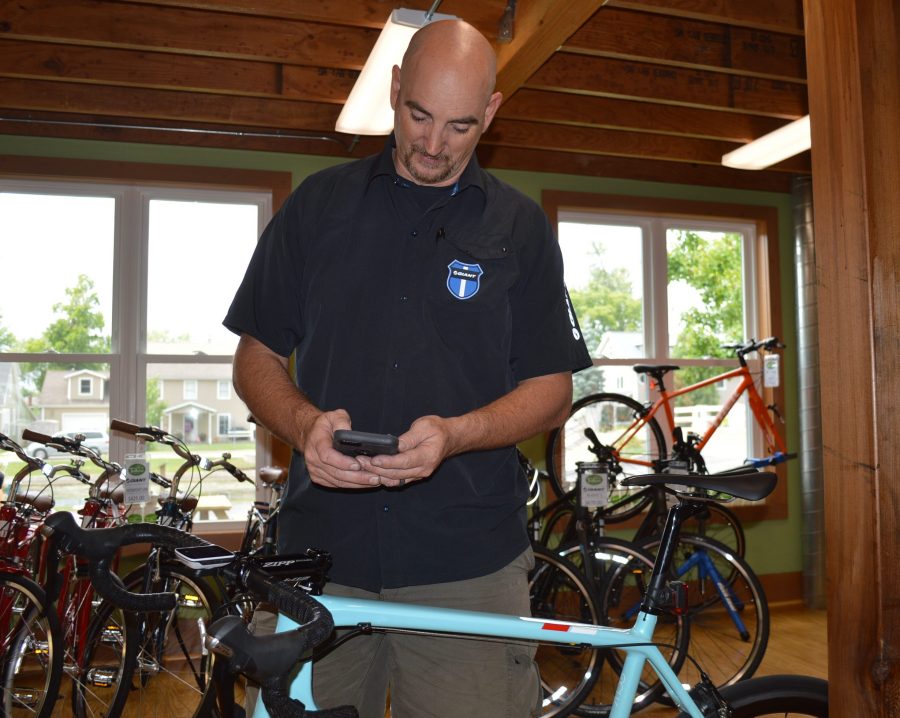Technology Trends With Riding Bicycles

As demonstrated by Barry McManus, owner of Trailhouse Village Bicycles, using a smartphone is popular among bicycle enthusiasts to track mileage, speed and routes ridden.
KOSCIUSKO COUNTY — Digital technology has affected many facets of daily living. It should come as no surprise, then, technology has also impacted bicycling.
If you are, for the sake of an example, a middle-aged adult, remember those seemingly carefree days of pedaling a bicycle with only a few speeds and pretty simple in design? Bicycles, accessories and the digital technology associated with biking, though, have spawned numerous changes through time.
Barry McManus, owner of Trailhouse Village Bicycles in Winona Lake, noted a current trend involving bicycling is electronic shifting on road and mountain bikes. “It’s done by motors,” he said. “You push a button and it (gear shift) moves automatically.”
He went on to say the electronic shifting never misses and is “perfect every time.” No cable adjustments are needed. Anyone who has ever ridden a bicycle with manual gear shifting knows, sometimes, the gears do not shift as intended.
E-bikes, or electronic assisted bikes, are developing on a global scale, though McManus noted they are not being seen much yet in the Midwest. A motor is attached to the rear wheel and there is a sensor on the crank. When pedaling, it doubles the force put to the pedal.
There is also wireless shifting using Bluetooth technology, he added.
Though not a very recent trend, something gaining in popularity is using smartphone apps to track mileage and speed of bicycle rides. Strava and MapMyRide are the two most popular apps, McManus said. They each track mileage and speed and will map out a route ridden.
“It’s a fitness thing,” he said. “It gives credibility to what you are doing. You watch each other. Strava puts out challenges to ride so many miles.”
Bluetooth technology can be used instead to save the battery life on the smartphone. Bluetooth is connected through a sensor and the information can be sent to the phone.
Strava will track elevation changes while riding, as well as the heart rate of the rider. And it, along with MapMyRide, will allow rides to be posted on social media, such as Twitter and Facebook, for friends to see. Friends are able to click on the link and see the distance of the ride, as well as the speed and route taken.
Coming someday not too far away, McManus said, will be a spray on type paint to put on clothes to make them more reflective. It sprays on clear and will especially help those who ride bicycles at night to be seen better.
Technology has clearly impacted bicycling, but so has the ease of use of the technology, said Greg Demopoulos, president of the Kosciusko County Velo Cycling Club. “From apps to websites to social media to GPS, as well as integrated technology like power meters that monitor the wattage you put on the cranks, or electronic shifting systems,” he said.
The average bicyclist, bike shop or cycling club can use technology such as social media, apps and GPS to share different bike routes, personal statistics and events in a way that has increased awareness, participation and personal challenges for bicycling. “As a result, you’ve also seen mainstream mapping services like Google Maps now showing bicycle routes in particular town due to the demand and participation for bicyclists,” he said.
For quite a few years now, those who like to take their bicycles along while traveling can scope out places to ride online. Not only are bicycle routes marked online, but many cycling clubs have an online presence and can be contacted to offer input and suggestions.
And Demopoulos noted high end technology such as disc brakes, tubeless tires and carbon fiber frames are now standard on bikes and cost considerably less than they used to.
